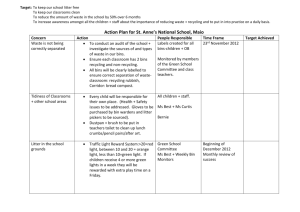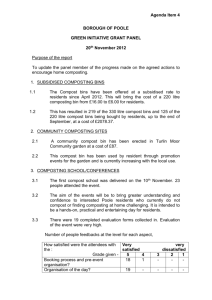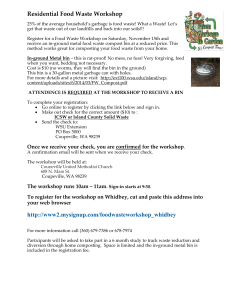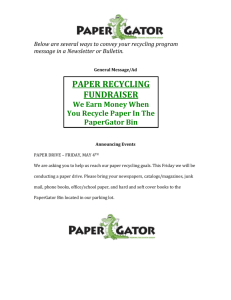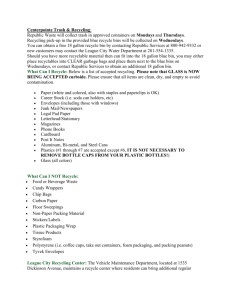File - Reduce, Reuse, Recycle
advertisement
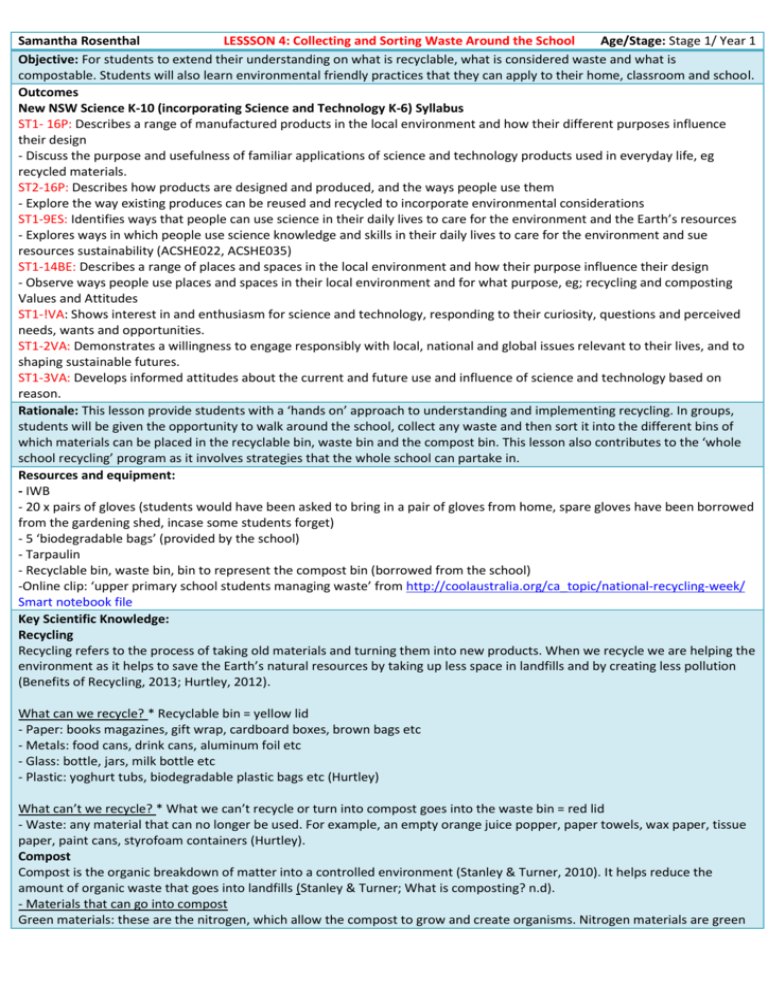
Samantha Rosenthal LESSSON 4: Collecting and Sorting Waste Around the School Age/Stage: Stage 1/ Year 1 Objective: For students to extend their understanding on what is recyclable, what is considered waste and what is compostable. Students will also learn environmental friendly practices that they can apply to their home, classroom and school. Outcomes New NSW Science K-10 (incorporating Science and Technology K-6) Syllabus ST1- 16P: Describes a range of manufactured products in the local environment and how their different purposes influence their design - Discuss the purpose and usefulness of familiar applications of science and technology products used in everyday life, eg recycled materials. ST2-16P: Describes how products are designed and produced, and the ways people use them - Explore the way existing produces can be reused and recycled to incorporate environmental considerations ST1-9ES: Identifies ways that people can use science in their daily lives to care for the environment and the Earth’s resources - Explores ways in which people use science knowledge and skills in their daily lives to care for the environment and sue resources sustainability (ACSHE022, ACSHE035) ST1-14BE: Describes a range of places and spaces in the local environment and how their purpose influence their design - Observe ways people use places and spaces in their local environment and for what purpose, eg; recycling and composting Values and Attitudes ST1-!VA: Shows interest in and enthusiasm for science and technology, responding to their curiosity, questions and perceived needs, wants and opportunities. ST1-2VA: Demonstrates a willingness to engage responsibly with local, national and global issues relevant to their lives, and to shaping sustainable futures. ST1-3VA: Develops informed attitudes about the current and future use and influence of science and technology based on reason. Rationale: This lesson provide students with a ‘hands on’ approach to understanding and implementing recycling. In groups, students will be given the opportunity to walk around the school, collect any waste and then sort it into the different bins of which materials can be placed in the recyclable bin, waste bin and the compost bin. This lesson also contributes to the ‘whole school recycling’ program as it involves strategies that the whole school can partake in. Resources and equipment: - IWB - 20 x pairs of gloves (students would have been asked to bring in a pair of gloves from home, spare gloves have been borrowed from the gardening shed, incase some students forget) - 5 ‘biodegradable bags’ (provided by the school) - Tarpaulin - Recyclable bin, waste bin, bin to represent the compost bin (borrowed from the school) -Online clip: ‘upper primary school students managing waste’ from http://coolaustralia.org/ca_topic/national-recycling-week/ Smart notebook file Key Scientific Knowledge: Recycling Recycling refers to the process of taking old materials and turning them into new products. When we recycle we are helping the environment as it helps to save the Earth’s natural resources by taking up less space in landfills and by creating less pollution (Benefits of Recycling, 2013; Hurtley, 2012). What can we recycle? * Recyclable bin = yellow lid - Paper: books magazines, gift wrap, cardboard boxes, brown bags etc - Metals: food cans, drink cans, aluminum foil etc - Glass: bottle, jars, milk bottle etc - Plastic: yoghurt tubs, biodegradable plastic bags etc (Hurtley) What can’t we recycle? * What we can’t recycle or turn into compost goes into the waste bin = red lid - Waste: any material that can no longer be used. For example, an empty orange juice popper, paper towels, wax paper, tissue paper, paint cans, styrofoam containers (Hurtley). Compost Compost is the organic breakdown of matter into a controlled environment (Stanley & Turner, 2010). It helps reduce the amount of organic waste that goes into landfills (Stanley & Turner; What is composting? n.d). - Materials that can go into compost Green materials: these are the nitrogen, which allow the compost to grow and create organisms. Nitrogen materials are green as they rot quickly, for example: grass, vegetable peels, salad, fruit scraps, old flowers. Brown materials: are the carbon, as they provide the compost with energy. These include; egg cartons, leaves, branches (Stanley & Turner; What is composting?). - Materials that can that never go into compost include; bread, meat, plastic bottles, plastic packets as they do not rot and can attract vermin (Stanlery & Turner; What is composting?). Layout of the lesson: 1-1 1/2 hour Introduction to the lesson: - Open the IWB and play the video ‘upper primary school students managing waste’ (third video in the line) from 1:35 http://coolaustralia.org/ca_topic/national-recycling-week/ (Cool Australia, n.d) - Ask the students what happened in the video and discuss what the students in the video were doing/ why (recycling using the different colored bins/ composting) - Open the IWB (see notebook resource page 1) and go through the poster of what can be recycled in the yellow bin. Then using the notebook resource (page 2) which shows the different bins (recycling, waste, compost), ask students to come to the board to drag which bin the item will go into (answers are on page 3) - Ask students if they recycle at home by having the yellow bins (for homework that week students would have needed to look around their home and ask their parents if they recycle at home, as they may have a different colored bin depending on which area they live in) - Make a tally on the IWB (notebook resource page 3) of the students who do and don’t recycle (at the end of the unit, another tally will be made to compare if more students recycle at home) Activity: Collection - Explain to students that in groups they are going to walk around the school and collect waste that has been left on the ground (organized with the principal and year coordinator that Year 1 students will collect waste during different times of the day. All staff will be notified to not pick up waste left on the ground) - Before starting, each student will be asked to collect their gloves from their bags and given a safety talk to ensure students do not pick up sharp/ dangerous objects) - The class will be split into 5 groups of 4 (3 parents would have been previously asked to volunteer for the half and hour to supervise a group). Each group will be designated a different area, for example, the cola, play ground, eating area, grass area and tennis courts. Each group will be given 15/20 minutes to go their area and pick up as much rubbish. - After the 15/20 minutes all groups will re-assemble outside of the classroom where a tarpaulin will be on the ground. Each group will empty their bag of rubbish onto the tarpaulin. - The students will then sit around the tarpaulin, with the 3 bins at the opening of the circle (yellow = recycle, red = waste, compost) (parent volunteers will be welcomed to either stay or leave at this point) - Go through each bin and ask students what goes into each bin (explain to students that the compost bin made in the previous lesson is too heavy to carry, thus they will place any compost materials in another box, and after the lesson is finished, two students will take the box to the garden and empty it into the compost bin) - Going around the circle, each student will pick a piece of rubbish (or two/three if there is a lot of rubbish – ensure all students will get a go) and chose which bin it will go into and explain why (keep going around the circle until all rubbish has been sorted) Conclusion - In groups, students will then wash their hands in the bathroom and return to the classroom Students will then and discuss * Why they think they have done this? * What do they think they could do in their classroom/ school/ home to manage the different wastes produced? Modifications: Extension: - When students chose a piece of rubbish to place in a bin, if - Students could create posters to place around the school to they are un-sure they may chose a friend to help them inform the school about how they could manage the different - The poster of what can be recycled has both pictures and wastes produced. eg; what can and can’t go into the compost writing bin - Students could also prepare a presentation on how to manage the different wastes found around school, for assembly References Australian Academy of Science. (n.d). Making Packaging Greener – Biodegradable plastics. Retrieved October 26th 2013 from http://www.science.org.au/nova/061/061key.html Discovery Communications (2013). Corn plastic. Retrieved October 27th 2013 from http://dsc.discovery.com/tv-shows/other-shows/videos/how-stuff-works-corn-plastic.htm Organics Australia Online. (2012). Organic gluten free maize cornstarch. Retrieved 30th October 2013 from http://www.organicsaustraliaonline.com.au/prod2208.htm?utm_source=myshopping&ut%20m_mediu m=cpc&utm_campaign=Groceries&utm_term=The+Gluten+Free+Company+organi%20organic+gluten+fr ee+maize+corn+starch Plastic biodegradation in landfills. (n.d). Retrieved October 26th 2013 from http://greenplastics.net/news/45-science/93-plastic-biodegradation-in-landfills Science Off Center. (n.d). Corn starch plastic. Retrieved October 27th 2013 from http://www.scienceoffcenter.org/science/310-corn-starch-plastic Tokiwa, Y., Calabia, B., Ugwu, C., & Aiba, S. (2009). Biodegradability of plastics. International Journal of Molecular Science 10(9), 3722-3742. doi: 10.3390/ijms10093722


